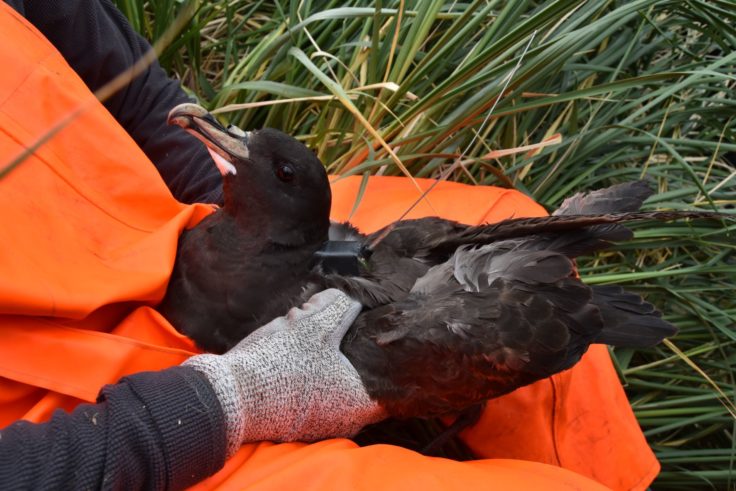Vulnerable seabirds tracking reveals foraging patterns
A project studying the at-sea distributions of white-chinned petrels from South Georgia is now running for a second season – and early data suggest there are important differences in foraging patterns across breeding sites.
In December 2022, BAS scientists fitted breeding white-chinned petrels at King Edward Point and Bird Island in South Georgia with Platform Terminal Transmitters (PTTs), allowing the birds’ locations to be tracked via satellite.
Seabirds are amongst the most globally threatened birds, and the white-chinned petrel is listed as Vulnerable on the Red List published by the International Union for Conservation of Nature (IUCN). Although bycatch in local South Georgia fisheries is now minimal, white-chinned petrels are one of the most common seabirds killed in South American fisheries. Almost all of these birds come from the South Georgia breeding population.
The adult petrels were incubating eggs when the tracking devices were fitted. The project aims to track their movements at sea until the late chick-rearing phase, when the batteries in the transmitters will run out. Some nests may fail due to natural causes, in which case the adults will likely leave South Georgia in the next 1-2 months and migrate to South American waters.

Scientists hope that the project will help us understand more about variation in foraging patterns of birds from different sites, and whether this leads to differences in fisheries overlap and bycatch rates.
Project leader, Dr Victoria Warwick-Evans commented:
“The main aims of the project are to map the at-sea distributions and habitat preferences of birds breeding at different sites across South Georgia, and to identify the fishing fleets that likely pose the highest risk. This increased knowledge will focus conservation and management efforts and help safeguard the future of these globally important seabird populations.”
Early data from the December deployments shows the routes of white-chinned petrels tracked from Bird Island (red) and King Edward Point (green). The birds have been travelling to similar foraging areas on the Patagonian Shelf and near the Antarctic Peninsula, but so far only birds from King Edward Point have fed in waters to the north or east of South Georgia.
![]()
The Spatial Segregation of Seabirds at South Georgia research project is focusing on four species: wandering albatross, northern giant petrel, southern giant petrel and white-chinned petrel. The research project is led by the British Antarctic Survey and funded by the Darwin Plus scheme, Friends of South Georgia Island and the Government of South Georgia and the South Sandwich Islands (GSSSI), which also provided logistical support via the MV Pharos SG.